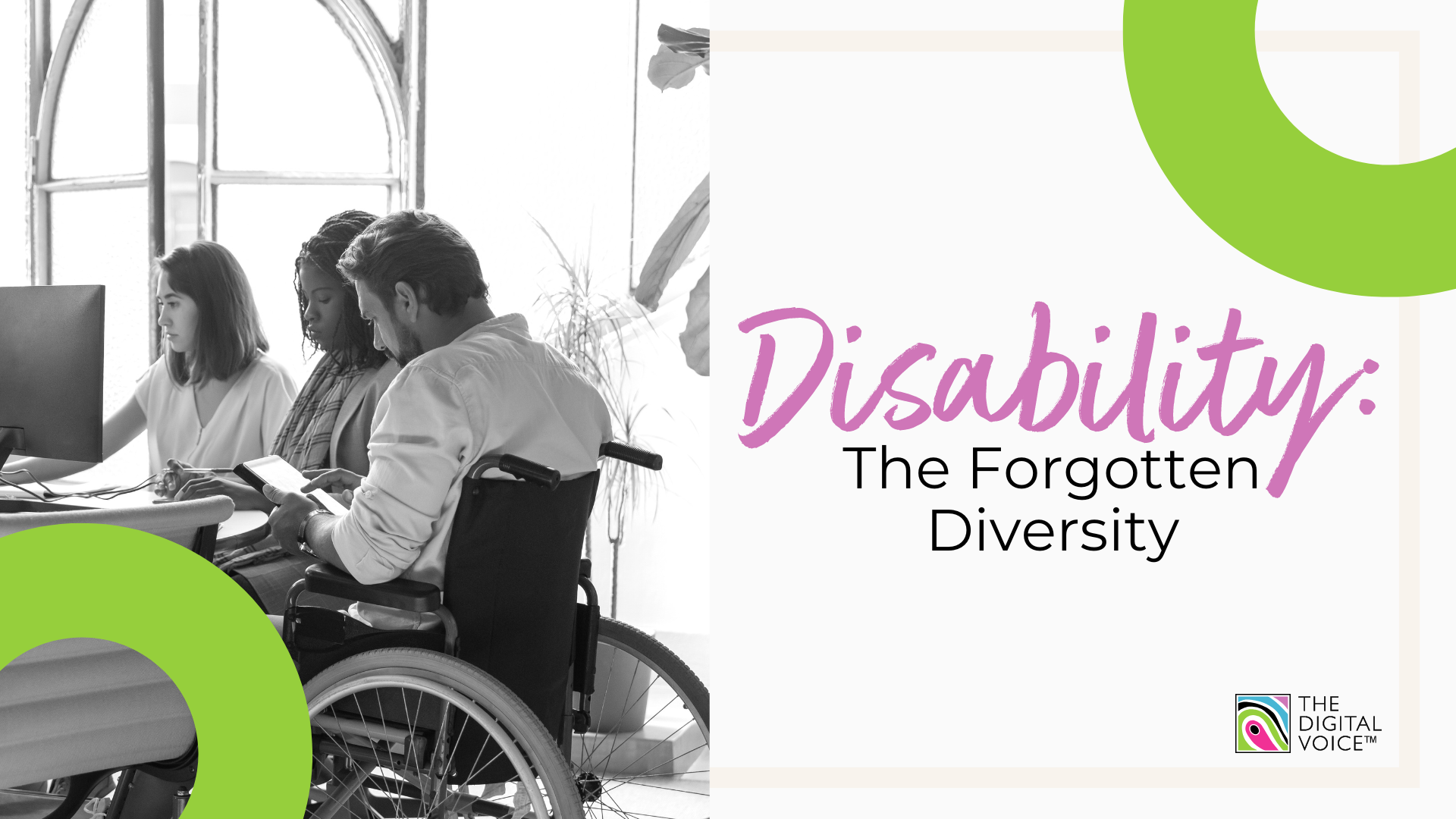Disability: The Forgotten Diversity
by Ren Bowman

Conversations surrounding diversity and inclusion have skyrocketed in the past few years. At this year’s MAD//fest, The Digital Voice™ were partners of the Female Leaders Bar, with our founder and CEO Julia Linehan hosting a number of interviews on the stage with some inspiring leading ladies from across the industry. It was incredible to watch, both for the important topics that were covered and for the engagement from attendees – the benches filled up and the crowd spilled out onto the floor, the sound system even ran out of headphones for people to listen in, talk after talk. It left us listening with a growing sense of hope – while there’s still a large gender gap in the workplace here in the UK, it’s clear the gap is closing in both the statistics and in people’s minds. As it should be.
The conversations also got me thinking about other diversity groups who don’t see the same sort of recognition. One reason gender equality is on the rise is the efforts of women to be seen and create change en masse – change isn’t the result of a single figure or a small group of voices, it spans generations of work. “Use your voice,” was the message of multiple speakers on the Female Leaders stage. And of course, Julia’s signature statement is “Be loud, be brave, be bold, be you.”
But one marginalised group often struggles in isolation: people with disabilities. Unlike gender, ethnicity, or sexuality – without diminishing the equality battles those groups face in any way – people with disabilities frequently lack the strength in numbers to bring about change or raise their voices loud enough to be heard.
One of the reasons for this is just how diverse this group is. There is such a huge range of disabilities out there – ranging from the physical, such as visual impairment or long-term injuries, to the mental as with learning disorders and neurodiversity, to often invisible chronic illnesses. In fact, one in every five people struggles with a disability in their lifetime. And yet, only 4% of organisations include disabilities in their diversity efforts. Each disability has unique problems and unique experiences and is balanced with very different solutions. There’s no obvious or blanket method to assist differently-abled people in the workforce, and all of these things add up to make support systems appear to be a complicated ask. On top of that, intersectionality between disability and other marginalised groups often leaves people with disabilities with even more on their plate than most can imagine facing.
According to research in the US and Australia, employers typically estimate 4-7% of their employees have a disability, but a
2023 BCG report,
“Your Workforce Includes People With Disabilities. Does Your People Strategy?”, has found the number to be more like 25%. This vast underestimation is due to two things: underreporting by employees due to fear of stigma or job insecurity, and a prevalent mindset of dismissal, in which someone has to look like their struggling before their difficulties are recognised. This is particularly troubling for the 80% of people with non-apparent disabilities, especially for those who’ve spent a lifetime of practice in adapting to cope and go unnoticed.
It’s time to start considering disability with the same seriousness we approach other forms of diversity, and put the work into allyship. Luckily, the BCG report also lays out three approaches to doing so that don’t look as complicated.
Policy and program creation
that supports employees and promotes understanding and inclusion, such as flexible working, company-wide training on DEI, and personal support from a manager – none of which needs to be limited to employees with disabilities, and all of which benefit the whole team.
Mentorship that goes beyond assisting people with disabilities in finding a role, and actually helps build a career path. Mentorship is hugely beneficial to all employees, helping people to feel noticed, supported, and encouraged toward their aspirations. Mentorship for women was widely discussed on the Female Leaders stage, with an emphasis on how important it is for diversity within the pool of mentors too, and the same applies to those mentoring people with disabilities – people learn best from a wealth of different experiences.
Accommodations for disabilities
unique to the employees who experience them. This could be anything from adjustments to someone’s physical environment to a particular piece of software, to working arrangements that accommodate unique needs. The BCG study found that 75% of employers found these sorts of accommodations to be extremely effective and very affordable, with 56% of adjustments costing nothing at all. To make this happen, employers and managers need to promote a safe space for reporting disability and requesting accommodations and need to meet their employees with disabilities halfway.
Writer Anais Nin said “We do not see things as they are, we see things as we are”, and that is never more true than when it comes to conversations around diversity. It’s genuinely difficult to put yourself in someone else’s shoes when you haven’t lived their experiences, and barriers for some people may not even register for those who don’t face them. But creating flexible workplace cultures where all employees are supported fairly and equally is only ever going to benefit everyone and drive more progress, success, and happiness. Next time you’re part of a conversation around diversity, whether at work or out of it, don’t forget to include those with disabilities. After all, a rising tide lifts all boats.

Ren Bowman is Senior Marketing and Multimedia Producer at The Digital Voice™, a first-class graduate in Creative Writing and an award-winning podcast producer. They’ve written for a range of industries including tech, entertainment, education, business finance, and lifestyle. Outside of work, they are an activist for social justice, especially Women’s and LGBTQ+ rights.



